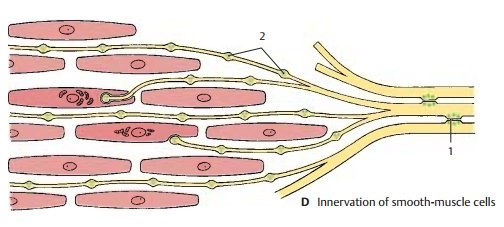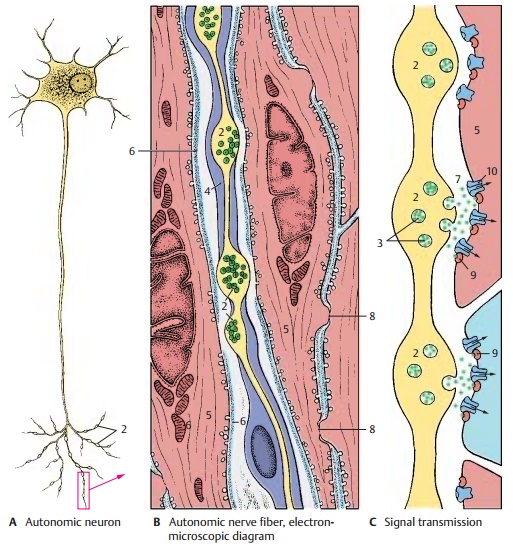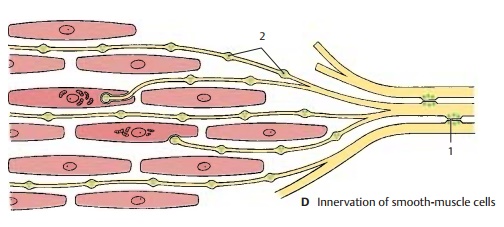Chapter: Human Nervous System and Sensory Organs : Autonomic Nervous System
Autonomic Neurons: Structure and Signal Transmission

Autonomic Neurons
Structure (A, B, D)
The autonomic nervous system consists of numerous individual elements, the auto-nomic neurons (A) (neuron doctrine). The theory of neuronal continuity, which hadlong been postulated for the terminal rami-fications of the autonomic nervous system, has been disproved by electron-microscopic studies. According to the continuity theory, the terminal ramifications of an intramural plexus were thought to form a continuous network (terminal reticulum), in which the processes of different neurons would fuse with each other and with the innervated muscle cells and glandular cells. The net-work was thought to represent a syncytium where nerve fibers share a common cyto-plasm. The electron-microscopic image does not show such continuity.

However, the postganglionic neurons do have specific features. The bundles of nerve fibers exhibit numerous axo-axonal syn-apses (D1), not only among sympathetic andparasympathetic fibers themselves but also between sympathetic and parasympathetic fibers. In the area of terminal ramification, specific structures corresponding to the motor end plates at striated muscles are absent. The only remarkable features are varicose swellings (varicosities) (A – D2) along the terminal branches of the axons.

The axon swellings may lead to indenta-tions on the smooth-muscle cells or may even invaginate the cells. In general, however, they lie between the muscle cells without direct membrane contact (as they would in a synapse, ). The swell-ings contain clear and granular vesicles (C3) similar to those in presynaptic terminal boutons The granular vesicles have been shown to contain norepinephrine, the neurotransmitter of the sympathetic nervous system. The sheath of Schwann cells(B4) surrounding the terminal branches is absent in the area of the swelling, and the adjacent wall segment of the smooth-muscle cell (BC5) lacks a basement mem-brane (B6). This is the site of signal trans-mission from the autonomic nerve fiber to the smooth-muscle cell.
Signal Transmission (C)
The vesicles contained in the axon swellings release their content into the intercellular space (C7). The neurotransmitter molecules diffuse into the intercellular space, thereby transmitting the signal to a large number of smooth-muscle cells. Signal transmission also spreads via membrane contacts be-tween the muscle cells. The smooth-muscle cells are interconnected by gap junctions (B8) which function as electrical synapses (see p. 26). There is no basement membrane at gap junctions.
Efferent autonomic nerve fibers innervate the smooth muscles and glandular cells (secretory fibers). Innervation of glandular cells (blue cells in C) is essentially the same as that of muscle cells. The neurotransmit-ters released from the vesicles in the axon swellings (green dots in C) activate G pro-tein-coupled receptors (C9) on the surface of the innervated cell. G protein mediates the opening of ion channels (C10), thus trig-gering an intracellular cascade of signals. This results in the contraction of smooth-muscle cells or in the synthesis and release of glandular secretion by the glandular cells
Related Topics